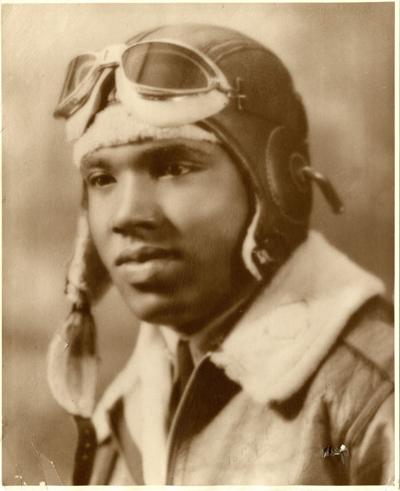
James Lawrence McCullin Jr. during World War II. McCullin served in the 99th Fighter Squadron, 332nd Fighter Group, U.S. Army Air Corps. Soldiers Memorial Military Museum Collections.
The Tuskegee Airmen of World War II were the first African American aviators in the United States military.
Lt. James L. McCullin Jr. was the first Tuskegee Airmen pilot from ÓŁĚŇĘÓƵ.
McCullin was born on Nov. 25, 1918, in ÓŁĚŇĘÓƵ. His parents were James and Bessie McCullin. He had two brothers, Elbert and Ernest, and two sisters, Vivian and Peggy.
A graduate of Sumner High School, McCullin was determined to achieve a college education. He attended Kentucky State College and worked during summers. A good student and athlete, he played football and basketball and was a member of the Alpha Phi Alpha social fraternity. In May 1942, McCullin earned a bachelor of arts degree.
Also in 1942, McCullin began training for African American aviators at the Tuskegee Army Flying School in Alabama. After successfully completing the course, he was commissioned as second lieutenant in September 1942.
McCullin paid for his mother Bessie’s travel expenses so she could attend her son’s graduation from flight school and wing-pinning ceremony.
About a week after graduation, McCullin’s future unit, the 99th Fighter Squadron, was declared combat ready.
The 99th Squadron arrived in North Africa in April 1943. Their first mission against enemy positions, in support of Operation Corkscrew, was on Pantelleria Island, June 2, 1943. The squadron sometimes conducted two missions a day.
On July 2, 1943, enemy aircraft attacked McCullin and others while they were escorting 12 B-25 bombers near the coast of Sicily. The squadron accomplished its mission by protecting bombers from the enemy, but McCullin and Lt. Sherman White did not return from the mission. According to the Missing Air Crew Report, a search conducted by the British Royal Air Force failed to locate the two downed pilots or their P-40L aircraft.
McCullin’s mother received a letter dated July 8, 1944, from the adjutant general, Maj. Gen. James Ulio. The general wrote that because McCullin had been missing for one year with no evidence of survival, his status had been changed to “presumptive finding of death” on July 3, 1944. Lieutenants McCullin and White were the first of 66 Tuskegee Airmen who paid the ultimate sacrifice during World War II.
McCullin’s name is inscribed on the Tablet of Missing at the American Cemetery in Tunisia and in the Court of Honor at Soldiers Memorial and Military Museum in ÓŁĚŇĘÓƵ. A memorial headstone stands at Jefferson Barracks National Cemetery in ÓŁĚŇĘÓƵ County, and James L. McCullin Hall is a dormitory named in his honor at Kentucky State University.
McCullin was awarded the Purple Heart, Air Medal and World War II Victory Medal. His image appears in a mural at Lambert International Airport in ÓŁĚŇĘÓƵ, honoring the legacy of the Tuskegee Airmen.
Explore the exhibit “Tuskegee Airmen: America’s Freedom Flyers,” open June 19 through Nov. 2, at Soldiers Memorial Military Museum. To learn more, visit .
McCullin’s family provided information contributing to this article.







